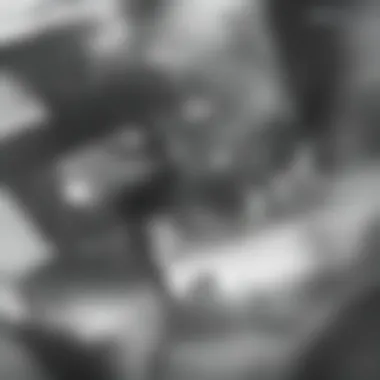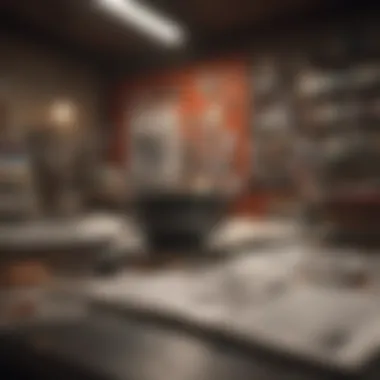Exploring Graphic Novel Degrees: A Comprehensive Overview


Intro
Graphic novel degrees are an intriguing area of study, merging literature with visual art to create unique narratives. This educational pathway appeals to those passionate about storytelling, whether through words or images. In recent years, the graphic novel medium has gained recognition not just as a form of entertainment but also as a valuable tool for communication across various fields.
Understanding the depth of graphic novel degrees involves exploring crucial concepts that underpin this discipline, including essential skills, industry trends, and potential career paths. The relevance of these degrees lies in their ability to train individuals for roles in a rapidly evolving creative industry, providing the necessary tools to excel in graphic storytelling.
Key Concepts
Definition of Primary Terms
To navigate the landscape of graphic novel degrees, it is important to clarify some key terms. A graphic novel is a book-length work of fiction or non-fiction that employs sequential art to convey a narrative. Unlike comic books, which are often serialized, graphic novels are typically standalone works with a cohesive storyline.
A degree in graphic novels often encompasses diverse disciplines such as visual storytelling, character design, writing techniques, and even digital media. These components aim to equip students with a holistic understanding of narrative construction.
Related Concepts and Theories
Graphic novels intersect with fields such as literature, art history, media studies, and cultural studies. Knowledge of these related concepts enriches one's understanding of how graphic novels operate within larger societal contexts.
Theories of visual communication, for instance, underline the significance of imagery in storytelling, while narrative theory offers insights into character development and plot structure. These frameworks help students appreciate the artistry behind graphic novels and guide their creative endeavors.
Industry Trends
The graphic novel industry is evolving, with increasing acceptance in mainstream culture. Publications like Maus and Persepolis have garnered critical acclaim, showcasing the potential of this medium to address complex themes. As more titles hit the shelves, the demand for skilled professionals who can produce high-quality graphic novels is on the rise.
The Role of Technology
The influence of technology cannot be overlooked. Digital platforms such as Webtoon and Tapas are reshaping how stories are told and consumed. Aspiring artists and writers must be adaptable, learning new skills related to digital graphic design and online publishing.
Future Directions
Gaps Identified in Current Research
While there is substantial literature on graphic novels, certain gaps remain in academic research. For example, the impact of graphic novels on literacy and education is still underexplored. There is a need for studies that examine how graphic narrative forms contribute to comprehension and engagement, particularly among younger audiences.
Suggestions for Further Studies
Future research should aim to investigate these untapped areas. This includes evaluating the efficacy of graphic novels in educational settings or their role in social movements. Such studies can provide insights that will further legitimize graphic novels within academic discourse.
"Graphic novels are not just a genre; they foster a unique way of seeing the world."
In light of these perspectives, exploring graphic novel degrees equips individuals with the skills needed to innovate and contribute meaningfully to this dynamic field. As the industry continues to expand and diversify, institutions must adapt their programs to prepare students for the challenges and opportunities that await them.
Preamble to Graphic Novel Degrees
The emergence of graphic novels as a significant medium within contemporary literature has led to the establishment of dedicated academic programs. These degrees not only foster the artistic and narrative potential of individuals but also contribute to a growing recognition of graphic novels across educational, cultural, and commercial spheres. This section aims to outline the significance of graphic novel degrees by discussing their definition, scope, and historical development.
Definition and Scope


Graphic novel degrees encompass a range of programs focused on the creation and analysis of graphic narratives. These degrees provide students with both the artistic and literary tools necessary to craft compelling visual stories. Generally, such programs include coursework in various aspects like drawing, storytelling, and character development.
The scope of these degrees is not limited to merely traditional teaching. They often incorporate digital media, enabling students to explore innovative storytelling forms. Graduates of these programs commonly find opportunities in publishing, illustration, and even game design, making this an adaptable and forward-thinking field of study.
Historical Context
The historical backdrop of graphic novels is crucial for understanding their place within education today. Initially dismissed as mere comic books, graphic novels have evolved significantly since the mid-20th century. The introduction of titles like Maus by Art Spiegelman and Persepolis by Marjane Satrapi marked a pivotal moment in recognizing the storytelling potential of this medium.
As interest grew, universities began to explore formal curricula centered around graphic novels. The establishment of programs dedicated to this art form indicates a shift in perspective toward viewing graphic novels as legitimate literature worthy of academic attention. Furthermore, as society increasingly values diverse forms of storytelling, the relevance and application of graphic novels in education and beyond continue to expand.
"Graphic novels synthesise visual art and literature, enriching the narrative experience and broadening the landscape of storytelling."
In summary, the introduction of graphic novel degrees captures an essential intersection of art and narrative. By understanding their definition, scope, and historical development, students and educators can better appreciate the academic value and vocational prospects of this unique discipline.
The Structure of Graphic Novel Programs
The structure of graphic novel programs plays a vital role in shaping the education of aspiring artists and writers. Understanding how these programs are designed can help students select the right path to achieve their goals. A well-structured program offers a blend of theoretical knowledge and practical skills. Students emerge equipped not only with the ability to create compelling narratives but also with the technical skills necessary to bring those stories to life.
Curriculum Overview
A comprehensive curriculum is essential for graphic novel programs. Such a curriculum is designed to cover key principles of both visual arts and storytelling. This approach allows students to develop a robust understanding of how images and words work together in the creation of graphic novels. Furthermore, a well-rounded curriculum helps students explore various genres and styles, which can enhance their versatility in the field.
Core Courses
Core courses form the backbone of graphic novel education. They are crucial for ensuring that students gain foundational skills necessary for success in this discipline.
Art Fundamentals
Art Fundamentals is a cornerstone course that introduces students to essential visual concepts. This course covers various techniques and mediums, encouraging experimentation and personal expression. A key characteristic of Art Fundamentals is its focus on both traditional and digital art forms. This dual approach is beneficial, as it prepares students for the modern publishing landscape. One unique feature of this course is the incorporation of critiques, allowing students to receive feedback on their work. This hands-on experience has the advantage of improving artistic skills in real-time.
Storytelling Techniques
Storytelling Techniques is another important core course. It delves into the narrative structure and elements essential for crafting engaging stories. The key characteristic of this course is its emphasis on combining visual storytelling with dialogue and character arcs. This holistic approach is a popular choice among students, as it presents a pathway to building complex narratives. A unique feature of this course is the analysis of existing graphic novels, which helps students understand successful storytelling strategies. One disadvantage may be the challenge of balancing creativity with structure, as students learn to adhere to certain narrative conventions while finding their unique voice.
Character Development
Character Development focuses on creating compelling and believable characters. This aspect is critical for graphic novels, where character dynamics often drive the plot. The course highlights the importance of backstory and motivation in character arcs. This is a beneficial aspect, as it prepares students to develop depth in their characters. A unique feature of this course includes workshops where students can create character profiles. This hands-on approach allows for immediate application of concepts learned. However, a potential disadvantage is that students may struggle with character consistency across different scenes, posing a challenge during the writing process.
Electives and Internships
Electives and internships are crucial components of graphic novel programs. These opportunities allow students to tailor their education according to their interests and career aspirations. Electives often cover specialized topics such as advanced illustration techniques or genre-specific writing. Internships offer practical experience in the industry, which is invaluable for building professional networks and gaining real-world insights. The benefits of these experiences are profound; they enhance students’ resumes and prepare them for the competitive job market.
Skills Acquired Through Graphic Novel Education
Graphic novels are more than just entertainment; they are a complex medium that merges visuals with narrative. Pursuing a degree in graphic novels equips students with various skills that are critical for both personal development and professional success. These skills go beyond basic drawing or storytelling; they encompass several interdisciplinary competencies. Each competency plays a vital role in one’s ability to contribute to the industry and engage with the audience on multiple levels.
Visual Communication
Visual communication is a cornerstone of graphic novels. It involves the ability to convey concepts, emotions, and messages through imagery. Students emphasize the vital role of visual content, learning how to create compelling images that complement or enhance text. This skill is essential in today's digital age, where visual literacy often influences decision-making and understanding. Students gain an appreciation for color theory, composition, and character design, fostering a more profound ability to express ideas succinctly. Strong visual communication not only strengthens artistic output but also aids in marketing one's work in an increasingly competitive industry.


Narrative Construction
The art of narrative construction involves the careful design of stories that are both engaging and meaningful. Graphic novel education teaches craft techniques essential for storytelling, ranging from establishing plot arcs to creating unique characters. Understanding the pacing and structure of a story enables creators to immerse readers in their worlds fully. Students study various genres and storytelling methods, learning how to balance action and dialogue effectively. Narrative construction is crucial as a well-told story can captivate audiences and drive emotional connections, thereby increasing the chances of commercial success.
Technical Proficiency
Technical proficiency encompasses a range of skills that are necessary for producing polished graphic novels. This includes an understanding of both digital tools and traditional printing techniques. Mastery of these techniques can significantly enhance a creator’s ability to execute their vision.
Digital Tools
In today's industry, proficiency in digital tools is essential. Software such as Adobe Photoshop, Clip Studio Paint, and Procreate dominate the market, providing artists with powerful utilities to create intricate artworks. These tools facilitate various styles and techniques, making them a popular choice among aspiring graphic novelists. One distinct feature of these digital platforms is their versatility—they allow for easy revisions and enable artists to experiment without the consequences associated with traditional mediums. Furthermore, understanding digital tools opens avenues for collaborations and self-publishing through platforms like Webtoons or Tapas.
Printing Techniques
Printing techniques remain a critical aspect of producing physical graphic novels. Students learn about various methods, including offset printing and digital printing, which offer different benefits depending on the project’s scale and budget. One key characteristic of printing techniques is their role in determining the final quality of the printed work. For instance, offset printing generally provides superior color fidelity and detail, making it a preferred choice for large runs. However, digital printing can be more cost-effective for smaller projects. Understanding these nuances helps graphic novelists make informed decisions when moving from digital to physical formats, thus enhancing their marketability.
"The integration of visual, narrative, and technical skills shapes the next generation of graphic novelists, allowing them to thrive in various creative fields."
In summary, the skills acquired through graphic novel education are extensive and multifaceted. They encompass visual communication, narrative construction, and technical proficiency. Each of these components is interlinked, creating a solid foundation for students as they prepare to enter the graphic novel industry. These skills do not only prepare students for specific roles but also equip them with a diverse toolkit applicable in various creative fields.
Careers in Graphic Novels
The field of graphic novels offers a variety of possible career paths. This segment highlights the significance of these careers in the context of graphic novel education. Pursuing a degree in this area not only provides one with technical skills but also fosters unique creative abilities. Additionally, the industry is continually evolving, presenting fresh opportunities. A deeper understanding of career options aids aspiring creators in making informed decisions about their professional journeys.
Publishing Opportunities
The publishing industry plays a vital role in the success of graphic novels. Those with graphic novel degrees can engage with traditional publishers like Marvel or DC Comics. Today, independent publishers also offer exciting alternatives.
Graphic novelists often collaborate with editors, designers, and marketing teams to publish their work. Exposure to various aspects of publication can be beneficial. A strong network can emerge through internships or freelancing, enhancing visibility and marketability.
- Traditional Publishing: Working with established companies that have a large reach.
- Independent Publishing: Opportunities with smaller, niche publishers that cater to specific audiences.
- Self-Publishing: Directly reaching readers via platforms such as Kindle Direct Publishing or Comixology.
Freelance Work
Freelancing offers great flexibility for graphic novel graduates. They can select projects that resonate with their interests and skills. This often includes work for hire, where they create illustrations or stories for clients.
Freelancers should cultivate a portfolio that showcases their style and versatility. Networking via social media or professional sites like LinkedIn can help in securing gigs. Here are some key points to consider about freelance work:
- Diverse Projects: Opportunities across different mediums, including magazines and online platforms.
- Personal Branding: Essential for attracting clients and building a recognizable presence.
- Time Management: Balancing multiple projects while meeting deadlines requires strong organizational skills.
Teaching and Academia
Teaching represents another valid career option for those passionate about graphic novels. Graduates can impart their knowledge at colleges or workshops. They may teach courses on visual storytelling, art techniques, or comic book history.
Positions may range from adjunct roles to full-time faculty ranging in numerous institutions. Not only does teaching provide steady employment, but it also offers the chance to influence future generations of creators. Key considerations include:
- Curriculum Development: The ability to create and refine courses tailored to the medium.
- Research Opportunities: Engaging with new trends or historical studies related to graphic novels.
- Community Engagement: Workshops can foster appreciation for the medium in local settings.


The diverse career opportunities in graphic novels reflect the medium's growing relevance, highlighting its professional landscape for aspiring artists and writers.
The Relevance of Graphic Novels Today
Graphic novels have increasingly become a vital component of contemporary culture and education. Their significance extends beyond mere entertainment; they serve as a dynamic medium for storytelling and a vehicle for social commentary. As this genre gains traction, understanding its relevance today is crucial for both creators and consumers. Torn between tradition and modernity, graphic novels reflect the complexities and nuances of contemporary society. This section will explore the critical elements of graphic novels, focusing on their cultural impact and integration in education.
Cultural Impact
Graphic novels hold a profound cultural significance in today's society. They function as a mirror, reflecting current issues, diverse voices, and varied experiences. The narrative style and visual elements of graphic novels allow for a multi-layered exploration of complex themes such as identity, justice, and community.
Some key aspects of their cultural impact include:
- Representation: Graphic novels often highlight marginalized voices, giving visibility to stories that may be overlooked in other media. This representation not only fosters understanding but also encourages empathy.
- Social Commentary: Many graphic novels address pressing societal issues. For instance, works like "Maus" by Art Spiegelman and "Persepolis" by Marjane Satrapi provide poignant insights into historical events and cultural realities.
- Cultural Exchange: The globalization of graphic novels has facilitated a rich exchange of ideas across borders, showcasing diverse art styles and storytelling techniques. Readership now encompasses a variety of demographics, creating spaces for intercultural dialogue.
"Graphic novels are not just for kids; they are a significant form of literature that engages readers of all ages and backgrounds."
Integration in Education
The integration of graphic novels into educational settings has become more prevalent. They are increasingly recognized as effective tools for teaching various disciplines, from literature to history. Their unique format caters to different learning styles, making complex subjects more accessible.
Here are some ways graphic novels are being incorporated into education:
- Enhanced Engagement: The combination of visual art and text captivates students, helping to maintain their interest in the subject matter.
- Critical Thinking: Analyzing graphic novels encourages students to think critically about narrative structure, symbolism, and artistic choices.
- Interdisciplinary Learning: Graphic novels often blend multiple genres, allowing educators to connect lessons across disciplines, such as art, writing, and social studies.
- Literacy Development: For struggling readers, graphic novels can bridge gaps in literacy. The visual context aids comprehension and vocabulary acquisition.
Epilogue and Future Directions
As we conclude our exploration of graphic novel degrees, it is necessary to consider the implications and future prospects within this field. The rising popularity of graphic novels has reshaped not only how stories are told visually but also how they are perceived in academia and industry. This section serves as a vital reflection on both the currents influencing graphic novels today and the emerging possibilities for future engagement with this unique medium.
Evolving Industry Trends
Currently, the graphic novel industry is experiencing significant transformations influenced by technology and shifting consumer preferences. Digital platforms like Webtoon and Tapas have democratized access to content, allowing creators to express their visions without traditional publishing constraints. Moreover, social media (like Instagram and Facebook) has enabled artists to build large audiences and receive real-time feedback. This connectivity fosters a collaborative culture where creators can experiment with form and content far beyond conventional boundaries.
The use of technology in graphic novels extends to production as well. Tools such as Adobe Creative Suite and Clip Studio Paint have become indispensable for artists. These digital tools facilitate faster production times and enable intricate designs that were once laborious to create on paper. Furthermore, advancements in printing technology have refined how graphic novels are published, paving the way for limited editions and more diverse distribution methods.
Key Takeaways on Industry Trends:
- Increased presence of digital platforms for comic publishing.
- Greater access to audiences through social media.
- Advanced digital art tools streamlining the production process.
The trend toward integrating graphic novels into educational curricula provides further insight. Many schools are recognizing their value, using comics to enhance literacy and engage contemporary narratives. This acceptance marks a significant shift in how literature and art are taught, illustrating the medium's educational potential.
"Graphic novels bridge the gap between text and visual art, making them powerful tools in education," notes a recent study from the Journal of Education and Visual Literacy.
Potential for Growth
As we examine the potential for growth, it becomes evident that graphic novel degrees are well-positioned to thrive in this evolving landscape. The creative economy is expanding, with various industries seeking talent skilled in storytelling, visual communication, and cross-disciplinary thinking. Graduates of these programs will find opportunities not only in traditional publishing but also in gaming, film, and marketing sectors.
Moreover, the global market for graphic novels continues to grow, driven by diverse audiences and increasing international collaboration. These factors underline the urgency for academic programs to adapt curricula that reflect industry demands and prepare students for multifaceted careers.
Additionally, scholarship and research in graphic novels are rising. This promotes academic discourse and elevates graphic novels' stature as a legitimate art form. As more institutions embrace research in this field, we can anticipate an influx of interdisciplinary studies that analyze graphic storytelling's impact across cultures and mediums.
Potential Areas for Development:
- Expand partnerships between educational institutions and industry leaders.
- Focus on building a multicultural narrative within graphic novels.
- Develop programs to support entrepreneurial training for creators.
In summary, the intersection of evolving industry trends and expansive growth potential presents a vibrant, dynamic arena for graphic novel degrees. By fostering talent that can navigate and shape these changes, we can anticipate a brighter future for both graphic novel creation and scholarship.



